IJCRR - 7(18), September, 2015
Pages: 46-56
Date of Publication: 20-Sep-2015
Print Article
Download XML Download PDF
A COMPARATIVE STUDY OF DENTAL ARCH FORM IN CASES WITH THUMB SUCKING, TONGUE THRUSTING AND NORMAL ARCH FORM USING EUCLIDEAN DISTANCE MATRIX ANALYSIS
Author: D. Ram Mundada, R.H. Kamble, Anuradha Rajkuwar, Sunita Shrivastava, Narendra Sharma, Rizwan Gilani
Category: Healthcare
Abstract:To compare dental arch form between the cases with thumb sucking, tongue thrusting and normal arch form using Euclidean distance matrix analysis\" Materials and Method: The sample consist of 30 patients ranging in age from 13 to 17 years were divided into three groups - Group 1- Subjects with thumb sucking habit, Group 2- Subjects with tongue thrusting habit and Group 3- Subjects without any history of habit. Study model impression was made and analysis of recorded data was carried out using a WinEDMA to compare the arch shape, size, inter-canine and inter-molar width. The statistical significance of the form difference was tested by using a \"bootstrap\" procedure.
Result: There was a significant arch-shape difference in the maxillary arches between thumb sucking subjects and subjects with no habits. Whereas significant arch-shape differences were found in the mandibular arch of tongue thrusting individual and those with no any habits. On comparing thumb sucking and tongue thrusting subjects, there was a significant arch-shape difference in the maxillary and mandibular arches. The arch size of tongue thrusting subjects was larger as compared to thumb sucking subjects. Conclusion: Expansion of narrow maxillary arch width in anterior region should be considered to harmonize with normal mandibular arch form in thumb-sucking subjects, whereas expansion of maxillary arch width I posterior region should be considered to harmonize with wider mandibular arch form in tongue thrusting subjects.
Keywords: Arch form, Thumb sucking, Tongue thrusting, EDMA
Full Text:
INTRODUCTION
Nature of equilibrium of the natural dentition is of primary importance to an orthodontist, whose concern is to achieve ideal and stable dental arches. Orthodontists are also concerned with patients oral habits since these may lead to abnormal growth and development of craniofacial structures.19 Arch form is a unique expression of individual development and probably no universal design will ever be able to account for many small but significant variations in the arch shape of the individual. It is commonly believed that the dental arch form is initially shaped by the configuration of the supporting bone and following the eruption of the teeth, by the circum-oral musculature and intraoral functional forces.17 Dental arch form consists of dental units arranged in unique positions along a compound curve, which represents a steady state of equilibrium delimited by the counterbalancing force fields of the tongue and the circum-oral tissues. The primary determinants of arch form morphology are the muscle forces of the resting state in contraction to the intermittent forces of muscle in functioning states. Considering the circum-oral structure as an elastic envelope, the lips and the cheeks exert counterbalancing inward tension against the teeth.19 Abnormal pressure habits changes the alveolar bone morphology and regulates the teeth in that bone. However these changes are taking place in living bone, one cannot revoke abnormal pressure habits as an etiology factor in developing malocclusion.12, 13 Studies evaluating the effects of digit sucking found that the shape of maxillary arch was modified in thumb- and digitsuckers by elongation of the anterior segment. This acts to produce spacing, labial inclination, and protrusion of the maxillary incisors. The creation of an excessive overjet in turn fosters abnormal lip and tongue muscle activity. The thumb sucking is normal in the first two or three years of life but may cause permanent damage if continued beyond this time. Maxillary and mandibular inter-canine and intermolar width, and anterior and posterior transverse inter-arch discrepancies in prolonged sucking habits showed association with the narrow maxillary inter -canine and inter- molar width, increased posterior transverse discrepancies and increase prevalence of posterior cross bite. Various methods have been used to compare the dental-arch forms in different studies but it was noted that Euclidean Distance Matrix Analysis (EDMA) has been extensively used in craniofacial morphological studies, as it provides a good measurement of form differences, separates the contributions of size and shape. It was found that prolonged thumb-sucking leads to a reduction in maxillary arch width particularly in canine region but no method provides good information about the major variations in the arch forms.15,16 Therefore, the present was conducted to evaluate and compare dental arch form in cases with thumb-sucking, tongue thrusting and normal arch form using “Euclidean Distance Matrix Analysis (EDMA)”
MATERIALS AND METHOD
Sample selection
Thirty patients, ranging in age from 13 to 17 years, were selected from the outdoor patients Department of Orthodontics, Sharad Pawar Dental College and students of Datta Meghe Institute of Medical Sciences (DU), Sawangi (M), and Wardha. The selected patients were divided into three groups comprising of 10 patients each as Group 1- Subjects with thumb sucking habit, Group 2- Subjects with tongue thrusting habit and Group 3- Subjects without any history of habit Study model impressions were made replicating all minute details, poured in dental stone and proper bases were formed. The data was processed at CAD-CAM centre, Department of Mechanical Engineering, VNIT (Regional Engineering College), Nagpur. YM-2115, three dimensional co-ordinate measuring machine was used for identification of landmarks on the study cast(Fig. A, Plate No. 1).11,21 It runs in the range of 150 mm X 200 mm X 100 mm and the accuracy of 3 orthogonal axes was 0.01 mm. The frictionless air bearing and touch trigger probe (0.5 mm) was used to identify the measuring point (i.e. anatomic point of each tooth) and to record the corresponding X,Y and Z coordinates to a computer data file. The analysis of recorded data was carried out using a WinEDMA version 1.0.1 beta as given by Cole TM.22
Method
Fourteen landmarks (midpoints of incisal edges, canine cusps and buccal cusps of premolars and first molars) were selected to represent the dental-arch form for maxillary and mandibular arch of each subject.1 The mesial contact point of the maxillary central incisors to the mesio-buccal cusp of the maxillary first molars was selected as the maxillary standard plane (Fig.1).
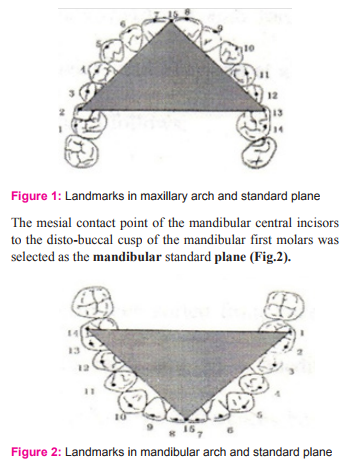
All measuring points were marked by the YM-2115, three dimensional co-ordinate measuring machine (Fig. B, Plate No. 1). The corresponding x, y and z coordinates were recorded in a computer data file (Plate No.2, 3, 4, 5). Fourteen landmarks representing both arches were projected to the corresponding standard plane. Then, a 2-dimensional EDMA was prepared to compare the arch forms between the 3 groups. In this study, the EDMA for arch form comparison was calculated as described by Lele and Richtsmeier1 and Ferrario et al6-8 using WinEDMA computer programme22. The procedure was as follows: All possible linear distances between pairs of landmarks were computed from the coordinates of the corresponding standard plane in each subject. This produced 10 maxillary matrices and 10 mandibular matrices of 91 distances (14x [14-1]÷2) in each group. Form matrices were then averaged for each arch in each group, thus obtaining 6 mean form matrices of maxillary and mandibular arches.
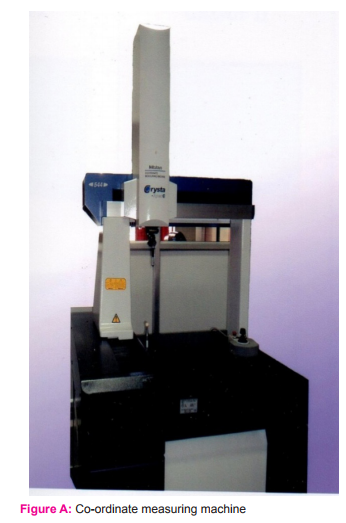
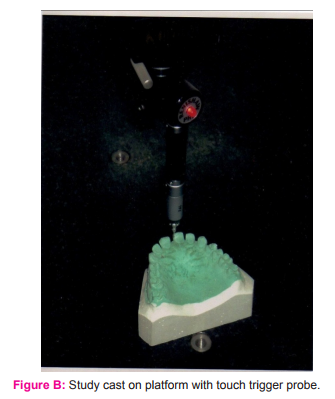
Statistical analysis:
The 91 ratio were then sorted from lowest to highest and the statistics, T= maximum ratio/minimum ration and M= medium ratio, were calculated. T represented the total range of arch-shape differences between the groups and M was a measure of general size difference by the form-difference matrices. The statistical significance of the form difference (i.e. Ho = similarity of forms, Ha = difference between forms) was tested by using a “bootstrap” procedure. The level of significance was set at 5%. The null hypothesis was rejected if the observed T statistics were in an extreme tail of the distribution- equal to or less than 5% (P =< 0.05).
RESULTS
There was a significant arch-shape difference in the maxillary arches between Group I and Group III subjects [(P1 <0.05) (Table 1)]. The anterior teeth explained most of the maxillary arch form differences between this two groups (P2 < 0.05) whereas the posterior teeth does not contribute to the maxillary arch form differences in this groups (P3 =0.160) For the mandibular arch, there was no significant shape difference in both the groups .The arch size of Group I subjects was larger as compared to group III subjects [1.1%(M1, Table 1)]. There was no significant arch-shape difference in the maxillary arches between Group II and Group III subjects [(P1 =0.112) (Table 2)] but in the mandibular arch, there was a significant arch-shape difference in both the groups [(P1 <0.05) (Table 5)]. The arch size of Group II subjects was larger as compared to group III. On comparing Group I and Group II subjects, there was a significant arch-shape difference in the maxillary and mandibular arches [(P1 <0.05) (Table 3) and (Table 6)]. The arch size of Group II subjects was larger as compared to group I.
DISCUSSION
The natural dentition always exists in equilibrium with and within the oral environment. Considering the relative stability observed in dental arch form during growth, the anatomic position of the dental arch is stabilized between the tongue and the circum-oral musculature and the experiences encountered in moving teeth and stabilizing them following treatment, all strongly supported the concept that the teeth reside in equilibrium in the undisturbed state. In 1967, Weinstein23 described changes in tooth position in response to small localized surface additions (bull loop and Burstone device), where encroachment upon adjacent tissues altered natural pressure phenomena. Upon removal of these additions, the teeth promptly returned in the direction of their origins. Intraoral form and function relationships are thus found on observations of stability which sustain the equilibrium concept which states, that teeth assume unique positions between the opposing forces of tongue and cheek musculature where a balance of forces is obtained. T. Aznar et al14 carried out study in thumb-sucking cases to evaluate dental arch form using vernier caliper. The dental arches were measured directly in the mouth and did not use study model. They found that thumb sucking leads to a reduction in maxillary arch width in the inter-canine region. According to Larsson15 and Ogaard16 et al, prolonged thumbsucking leads to a reduction in the maxillary inter-canine distance and an increase in the mandibular inter-canine distance. Straub24 and Tulley25 in a study of tongue thrusting cases evaluated its effect on dental arch form using study model cast and stated that tongue thrusting produces anterior open bite and spacing in maxillary and mandibular anterior teeth, commented that no method provides good information about the major variations in the arch form (size and shape). On the evaluation of maxillary arch shape, between thumb sucking (group I) and normal (group III) subjects significant arch shape difference was found (P1 < 0.05). Molar discrepancies was found, when anterior part of dental arch was taken into consideration by deleting posterior group of teeth (P2 < 0.05). Mandibular arch shape between the groups showed no significant difference (P1 = 0.210). The arch sizes were slightly larger in Group I subjects [1.1 % in maxillary arch (M1) and 0.7% in mandibular arch (M1)] as compared with Group III subjects. Similar results were found by Subtelny et al28 in their study in which dental casts of 34 children were measured and maxillary arch size as measured anterior to the first molars was found to be increased in the thumb-sucking group when compared with the normal cases. Mandibular arch size was also larger in the thumb-sucking group. In the present study, maxillary inter-canine and inter-molar widths in Group I were narrower as compared with Group III subjects. This can be deduced by the ratios between corresponding landmarks- e.g. the ratios of molar width were 1.031, whereas the ratios of canine width were 1.065. In the mandibular arch, the ratios of canine width were 0.985 and ratios of molar width were 1.006 whose values were close to 1 suggestive of similar arch width in canine and molar region in both the groups. These findings correlate with a comparison study of arch widths in cases with thumb-sucking habit and normal samples by Paola Cozza et al20 and T. Azner et al14. They measured inter-canine and inter-molar widths on the models. They concluded that thumb-sucking subjects had narrower maxillary molar and canine widths than normal subjects. No significant differences were found for mandibular inter-molar and inter-canine widths or anterior transverse discrepancy. But E. Larsson15 and B. Ogaard16et al found significant increase in inter- canine width in mandibular arch because of low position of the tongue during sucking. The difference in result between their study and the present study may be due to variation in sample selection as it was carried out in early childhood, and difference in method of arch form determination, as width was directly measured in the oral cavity. It was also found that the distance in cusp of canine to lateral incisor was larger in the Group I subjects as compared with Group III subjects. Other findings also suggest that maxillary arch forms in thumb-sucking subjects tend to be conical. These finding correlate with the findings of Ruttle et al18. They studied the shape of maxillary arch in thirty-six cases with thumb-sucking produces spacing and protrusion of the maxillary incisors. On the evaluation of mandibular arch shape, between tongue thrusting (group II) and normal (group III) subjects significant arch shape difference was found (P1 < 0.05)[Table 10 ]. Molar discrepancies was found, when posterior part of dental arch was taken into consideration by deleting anterior group of teeth (P3 < 0.05) [Table 10]. Maxillary arch shape between the groups showed no significant difference (P1 = 0.112). The arch sizes were larger in Group II subjects [10.5 % in maxil-lary arch (M1) and 9.9% in mandibular arch (M1)] as compared with Group III subjects. These findings confirmed Sim Wallace’s theory which states that “The tongue exercises make important mechanical influence on the general form and size of the mandible. Thus in tongue thrusting habit tongue is placed more anteriorly, thus increasing the arch size”.25 In the present study, mandibular inter-canine and inter-molar widths in Group II subjects were wider as compared with Group III subjects. This can be deduced by the ratios between corresponding landmarks- e.g. the ratios of molar width were 0.933, whereas the ratios of canine width were 0.820. This is because in Group II subjects tongue is positioned anteriorly and inferiorly, thus exerting lateral pressure on the mandibular dentition as explained by Cleall26 and Hanson and Cohen27. It was also found that the distance between anterior teeth were larger in the Group II subjects as compared with the Group III subjects. Other findings also suggest that maxillary arch forms in thumb-sucking subjects tend to be broader. Similar findings were found in a study conducted by Straub24 in which he studied dental arch form of 233 patients, who had tongue thrusting habit using study model cast. He concluded that, diastema is present in upper and lower anterior teeth along with generalized spacing. On the evaluation of maxillary arch shape, between thumb sucking (group I) and tongue thrusting (group II) subjects significant arch shape difference was found (P1 < 0.05). Molar discrepancies was found, when anterior part of dental arch was taken into consideration by deleting posterior group of teeth (P2 < 0.05). On the evaluation of mandibular arch shape, between thumb sucking (group I) and tongue thrusting (group II) subjects significant arch shape difference was found (P1 < 0.05)[Table 10 ]. Molar discrepancies was found, when posterior part of dental arch was taken into consideration by deleting anterior group of teeth (P3 < 0.05) [Table 10] The arch sizes were slightly larger in Group II subjects [10.9 % in maxillary arch (M1) and 10.8% in mandibular arch (M1)] as compared with Group I subjects. In the present study, maxillary inter-canine and inter-molar widths in Group I subjects were narrower than with Group II subjects. This can be deduced by the ratios between corresponding landmarks- e.g. the ratios of molar width were 1.120, whereas the ratios of canine width were 1.201. In the mandibular arch, the ratios of canine width were 1.201 and ratios of molar width were 1.079, suggestive of increased mandibular arch width in canine and molar region in Group II as compared with Group I.
CONCLUSION
There was a significant arch-shape difference in the maxillary arches between thumb sucking subjects and subjects with no habits. Whereas significant arch-shape differences were found in the mandibular arch of tongue thrusting individual and those with no any habits. On comparing thumb sucking and tongue thrusting subjects, there was a significant arch-shape difference in the maxillary and mandibular arches. The arch size of tongue thrusting subjects was larger as compared to thumb sucking subjects. Expansion of narrow maxillary arch width in anterior region should be considered to harmonize with normal mandibular arch form in thumbsucking subjects, whereas expansion of maxillary arch width I posterior region should be considered to harmonize with wider mandibular arch form in tongue thrusting subjects.
ACKNOWLEDGEMENT
Authors acknowledge the immense help received from the scholars whose articles are cited and included in references of this manuscript. The authors are also grateful to the authors / editors / publishers of all those articles, journals and books from where the literature for this article has been reviewed and discussed.
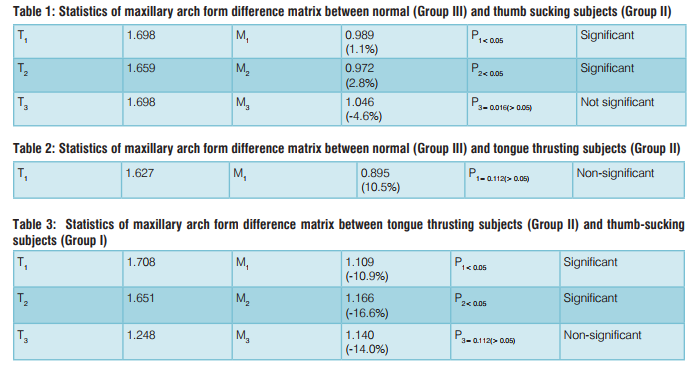
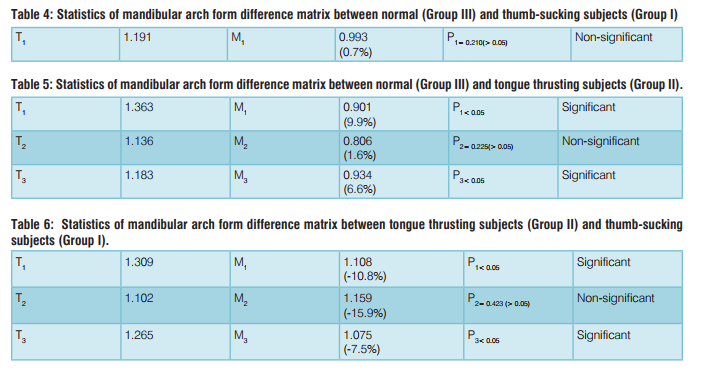
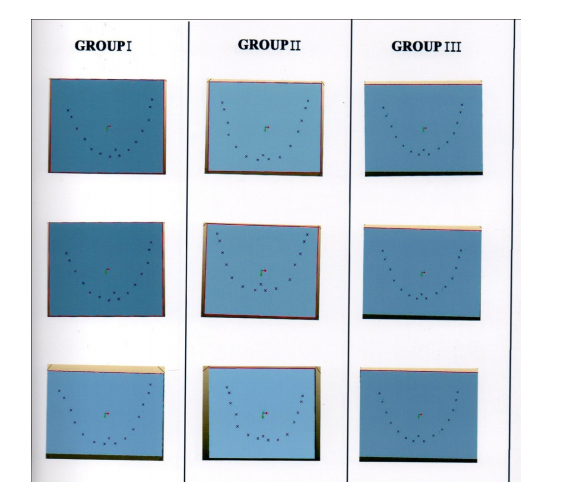
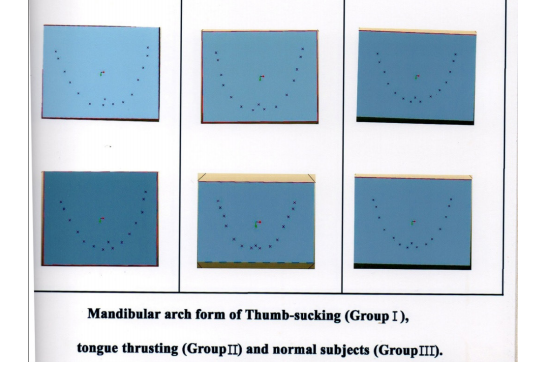
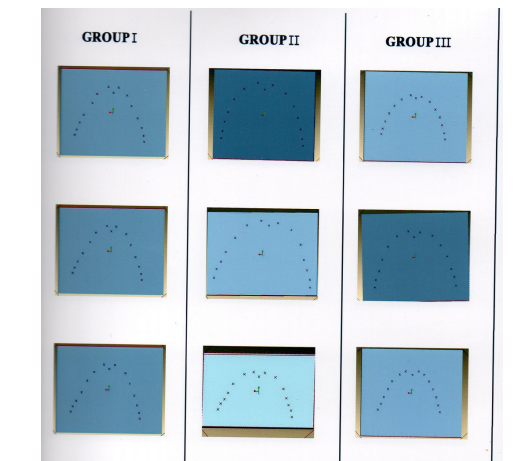



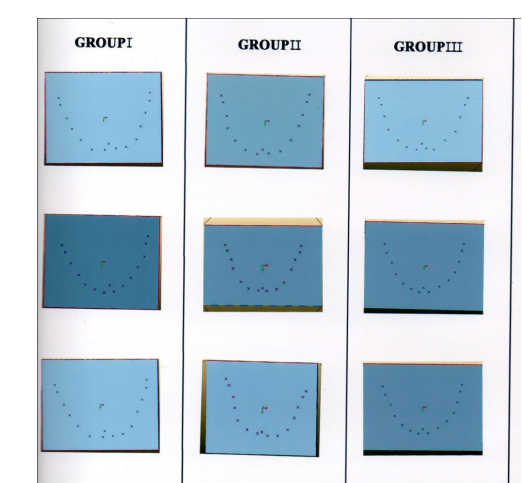

References:
1. Lele S, Richtsmeier JT. On comparing biological shapes: detection of influential landmarks. Am J Phys Anthropol 1992; 87:49- 65
2. Lele S. Some comments on coordinate- free and scale-invariant methods in morphometrics. Am J Phys Anthropol 1991; 85:407- 17.
3. Lele S, Richtsmeier JT. Euclidean Distance Matrix Analysis: Confidence Intervals for form and growth differences. Am J Phys Anthropol 1995; 98:73-86.
4. Hens SM. Growth and sexual dimorphism in orangutan crania: a three-dimensional approach. Am J Phys Anthropol 2003; 121:19-29.
5. Singh GD, Hodge MR. Bimaxillary morphometry of patients with Class II Division 1 malocclusion treated with Twin Block appliance. Angle Orthod 2002; 72:402-9.
6. Ferrari VF, S forza C, Miani A Jr, Serrao G. Dental arch symmetry in young healthy human subjects evaluated by Euclidean distance matrix analysis. Arch Oral Biol 1993;38:189-94.
7. Ferrari VF, S forza C, Miani A Jr, Tartaglia G. Maxillary verus mandibular arch form differences in human permanent dentition assessed by Euclidean distance matrix analysis. Arch Oral Biol 1994;39:135-9.
8. Ferrari VF, S forza C, Miani A, Tartaglia G. Human dental arch shape evaluated by Euclidean-distance matrix analysis. Am J Phys Anthropol 1993;90:445-53
9. Bell A, Ayoub AF. Assessment of the accuracy of a three dimensional imaging system for archiving dental study models. J Orthod 2003;30:219-23.
10. Nie Q, Lin J. A comparison of dental arch forms between Class II division 1 and normal occlusion assessed by Euclidean distance matrix analysis. Am J Orthod Dentofac Orthop 2006;129:528- 35.
11. Braun S, Hnat WP, Fender DE, Legan HL. The form of the human dental arch. Angle Orthod 1998;68(1):29-36.
12. Takayuki K, Takashi O. Diagnosis and Management of Oral Dysfunction. World J Orthod 2000;1:125-133.
13. Klein E. Pressure habits, etiological factors in malocclusion. Am J Orthod 1952;38:569-587.
14. Aznar T, Galan A.F, Marin I., Dominguez A. Dental arch diameters and relationships to oral habits. Angle Orthod 2006;76:441- 445.
15. Larsson E. Sucking, chewing and feeding habits and the development of crossbite: a longitudinal study of girls from birth to 3 years of age. Angle Orthod. 2001;71(2):116-119.
16. Ogaard B, Larsson E, Lindsten R. The effect of sucking habits, cohort, sex, inter-canine arch widths, and breast or bottle feeding on posterior crossbite in Norwegian and Swedish 3-year-old children. Am J Orthod Dentofac Orthop 1994;106:161-166.
17. Strang RH. The fallacy of denture expansion as a treatment procedure. Angle orthod 1949;49:12-7.
18. Ruttle AT, William Quigley, Crouch JT and George E. Ewan. A serial study of the effects of digit-sucking. J Dent Res 1953;32(6):739-748.
19. Brader AC. Dental arch form related with intraoral forces: PR=C. Am J Orthod 1972;61(6):541-561.
20. Paola Cozza, Tiziano Baccetti, Lorenzo Franchi, Manuela Mucedero, Antonella Polimeni. Transverse features of subjects with sucking habits and facial hyperdivergency in the mixed dentition. Am J Orthod Dentofac Orthop 2007;132:226-9.
21. Nie Q, Lin J. Comparison of intermaxillary tooth size discrepancies among different malocclusion groups. Am J Orthod Dentofac Orthop 1999;116:539-44.
22. Cole TM (2002). WinEDMA: Software for Eulidean distance matrix analysis. Version 1.0.1 beta. Kansas city: University of Missouri- Kansas City School of Medicine.
23. Weinstein S. Minimal force in tooth movement. Am J Orthod 1967;53:881-903.
24. Straub WJ. Malfunction of the tongue Part I. The abnormal swallowing habit: It’s cause, effects and results in relation to orthodontic treatment and stretch therapy. Am J Orthod 1960;46(6):404-24.
25. Tulley WJ. A critical appraisal of tongue thrusting. Am J Orthod 1969;55(6):640-50.
26. Cleall JF. Deglutition: A study of form and function. Am J Orthod 1965;51(8):566-594.
27. Hanson ML, Cohen MS. Effects of form and function on swallowing and the developing dentition. Am J Orthod 1973;64(1):63-82.
28. Subtelny J.D, Subtelny J.D. Oral Habits- Studies in Form, Function and Therapy. Am J Orthod Dentofac Orthop 1973;43(4):347- 383
|






 This work is licensed under a Creative Commons Attribution-NonCommercial 4.0 International License
This work is licensed under a Creative Commons Attribution-NonCommercial 4.0 International License